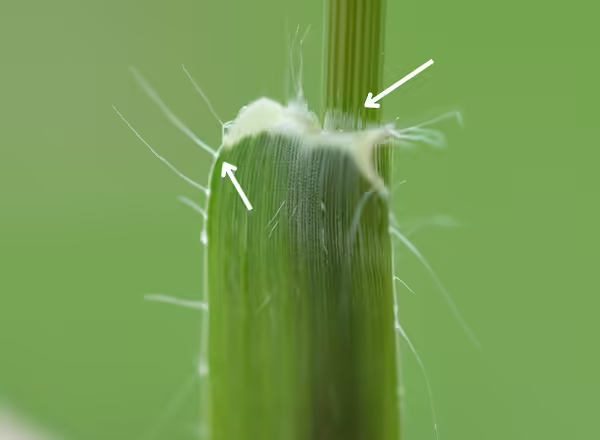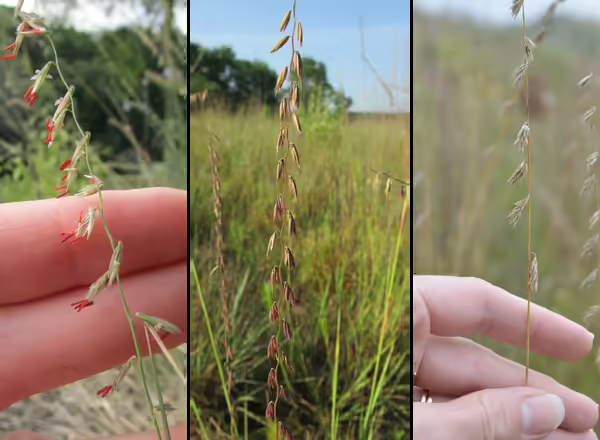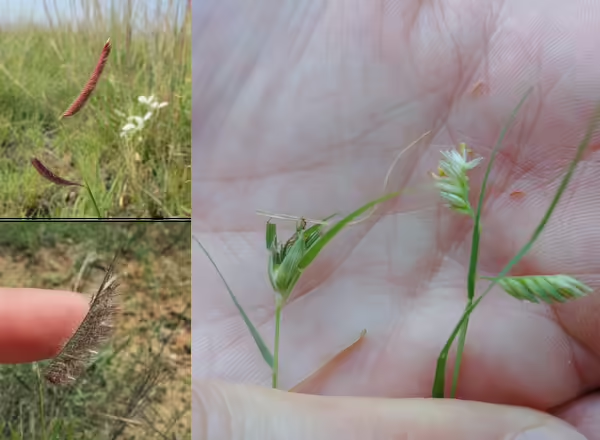
One of my favorite grasses started blooming during this past week – Side Oats Grama. I planted some in my garden last fall and am thrilled to see it blooming. Side Oats Grama is one of four grama grasses that can be found in Illinois, and by far the most common. The other three look much more like one another than they do Side Oats Grama.
What does grama mean? Grama comes from the Latin word grāmen, which means grass. The grama grasses (now that's a bit redundant isn't it?) belong to the genus Bouteloua, which is a fun Latin name to pronounce.
How do you identify Side Oats Grama? And how do you tell it apart from the other three, Buffalo Grass, Blue Grama, and Hairy Grama?
Where it grows
Side Oats Grama (Bouteloua curtipendula) is a native, warm-season grass that can be found in northern Illinois as well as counties in west-central and southern Illinois. You can find it growing in drier prairies sites, as well as glades and barrens.
What it looks like
Side Oats Grama is a short, slim grass, typically 2-3 feet tall. A helpful identification characteristic for this grass is the hairs that you can find along the margins, or the edges, of the leaf blades. These hairs are held on small glands along the edges of the leaves, and later in the season, you can still see the glands remaining when the hairs have fallen off.
The inflorescence of this grass is unique – it will develop a raceme inflorescence with a zig-zag rachis (stem of the inflorescence). The spikelets can be found in small clusters held on a stalk. The individual spikelets are awned, albeit with very short awns. The spikelet clusters resemble short eyelashes. The spikelets can be green to red in color, and turn brown in the fall. If you are lucky enough to catch this grass in flower, it has bright red anthers that you can see exserted (pushed out) from the spikelets.
As the season progresses, the inflorescence often nods to side, which leads to the name "Side" Oats Grama, as the spikelets will hang off one side of the rachis.



Other grama grasses
The three other grama grasses are all shorter in stature, typically under 1 foot tall. In Illinois, you are most likely to see them in the northern counties. Blue Grama (Bouteloua gracilis) is rare in Illinois, found in only a handful of counties, and most closely resembles Hairy Grama (Bouteloua hirsuta), which can be found in the northwest counties of the state. Buffalo Grass (Bouteloua dactyloides) can be found in the northeast counties of Illinois.
Besides the size of the grasses, the easiest way to tell them apart is by their inflorescences. Blue and Hairy Grama have raceme inflorescences with dense clusters of spikelets about 1-2 inches long (two to three times the size of the clusters of Side Oats Grama) that very much resemble an eyelash. Hairy Grama is much hairier than Blue Grama, has shorter racemes, and its clusters of spikelets do not extend across the entire branch, leaving a pointed tip (below top right). In contrast, the spikelets of Blue Grama extend across nearly the entire branch of the cluster. Buffalo Grass differs because it is dioecious, which means it produces separate male and female flowers, which are found on different plants. The spikelets of the male flowers are held in small clusters on stalk, more closely resembling Side Oats Grama. The female flowers are reduced.
Each of these three grasses is overall much smaller in size, and is much less common in Illinois than Side Oats Grama.
Have you seen any of the grama grasses before? Which one is your favorite?
Never miss a new post! Sign up for our email list.
ABOUT THE AUTHOR: Erin Garrett is a Natural Resources, Environment, and Energy Educator for University of Illinois Extension serving Alexander, Johnson, Massac, Pulaski, and Union counties. Erin develops and delivers high impact programming to adults and youth to help them develop an appreciation for natural resources and to empower them to make small changes to positively impact the environment. Erin’s programming focuses on why homeowners should consider choosing native plants, how to support native pollinators, how to identify grasses, how to identify and manage invasive species, and developing an appreciation for prairie ecosystems.
ABOUT THE BLOG: Grasses at a Glance dives into grass identification, focusing on tips and tricks that make grass identification possible. Get information about native and non-native species, how to tell look-alikes apart, and which grasses you can find in Illinois.